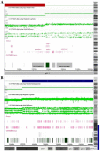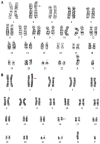Molecular cytogenetic characterization of partial monosomy 2p and trisomy 16q in a newborn: A case report
- PMID: 31363371
- PMCID: PMC6614715
- DOI: 10.3892/etm.2019.7695
Molecular cytogenetic characterization of partial monosomy 2p and trisomy 16q in a newborn: A case report
Abstract
Trisomy 16q is a rare disorder with severe abnormalities, which always leads to early postnatal mortality. It usually results from a parental translocation, exhibiting 16q duplication associated with another chromosomal deletion. The present study reports on the clinical presentation and molecular cytogenetic results of a small-for-gestational-age infant, consisting of partial trisomy 16q21→qter and monosomy 2p25.3→pter. The proband presented with moderately low birthweight, small anterior fontanelles, prominent forehead, low hairline, telecanthus, flat nasal bridge, choanal atresia, clinodactyly of the fifth fingers, urogenital anomalies, congenital muscular torticollis and congenital laryngomalacia. The last two traits have not previously been reported in any trisomy 16q and monosomy 2p cases. The proband was trisomic for the 16q21→qter chromosomal region with the karyotype 46,XY,der(2)t(2;16)(p25;q21)pat. The chromosomal anomaly was the result of unbalanced segregation of a paternal balanced translocation, 46,XY,t(2;16)(p25;q21). In this case, molecular cytogenetic analysis had a critical role in delineating the proband's clinical phenotype. Although this patient had a 16q21→qter duplication and a 2p25.3→pter deletion, the latter may have had mild phenotypic effects when associated with trisomy 16q. The literature was also reviewed, focusing on cases with the same breakpoints, localizations and clinical features reported in recent years.
Keywords: 16q trisomy; 2p monosomy; case report; molecular cytogenetic diagnosis; unbalanced segregation of a paternal balanced translocation.
Figures


Similar articles
-
Partial trisomy 16q21➔qter due to an unbalanced segregation of a maternally inherited balanced translocation 46,XX,t(15;16)(p13;q21): a case report and review of literature.BMC Pediatr. 2018 Jan 8;18(1):4. doi: 10.1186/s12887-017-0980-z. BMC Pediatr. 2018. PMID: 29310616 Free PMC article. Review.
-
A child with multiple congenital anomalies due to partial trisomy 7q22.1 → qter resulting from a maternally inherited balanced translocation: a case report and review of literature.BMC Med Genomics. 2018 May 8;11(1):44. doi: 10.1186/s12920-018-0366-6. BMC Med Genomics. 2018. PMID: 29739404 Free PMC article.
-
Perinatal findings and molecular cytogenetic analysis of de novo partial trisomy 16q (16q22.1-->qter) and partial monosomy 20q (20q13.3-->qter).Prenat Diagn. 2005 Feb;25(2):112-8. doi: 10.1002/pd.1083. Prenat Diagn. 2005. PMID: 15712324 Review.
-
Partial monosomy 2p and partial trisomy 4q due to paternal translocation t(2;4)(p25.1;q31.3).Coll Antropol. 2014 Jun;38(2):759-62. Coll Antropol. 2014. PMID: 25145019
-
Prenatal diagnosis and molecular cytogenetic characterization of de novo partial monosomy 3p (3p26.3→pter) and partial trisomy 16q (16q23.1→qter).Taiwan J Obstet Gynecol. 2016 Apr;55(2):288-92. doi: 10.1016/j.tjog.2016.02.015. Taiwan J Obstet Gynecol. 2016. PMID: 27125417
Cited by
-
A rare description of pure partial trisomy of 16q12.2q24.3 and review of the literature.Am J Med Genet A. 2021 Oct;185(10):2903-2912. doi: 10.1002/ajmg.a.62368. Epub 2021 Jun 1. Am J Med Genet A. 2021. PMID: 34061437 Free PMC article.
References
-
- Schmickel R, Poznanski A, Himebaugh J. 16q trisomy in a family with a balanced 15/16 translocation. Birth Defects Orig Artic Ser. 1975;11:229–236. - PubMed
-
- Laus AC, Baratela WA, Laureano LA, Santos SA, Huber J, Ramos ES, Rebelo CC, Squire JA, Martelli L. Karyotype/phenotype correlation in partial trisomies of the long arm of chromosome 16: Case report and review of literature. Am J Med Genet A 158A. 2012:821–827. doi: 10.1002/ajmg.a.32988. - DOI - PubMed
LinkOut - more resources
Full Text Sources
